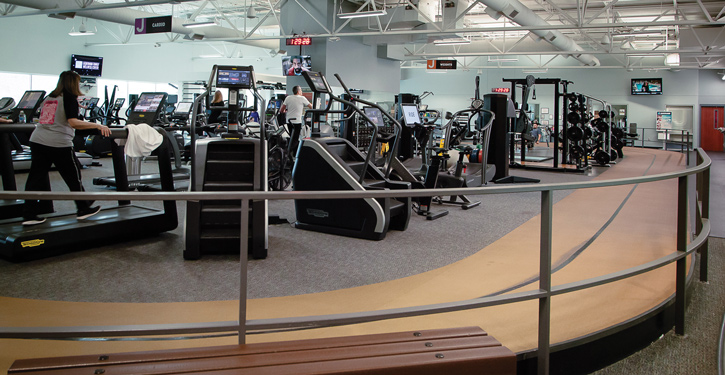Top strategies for fitness area budgeting and determining best value changes.
Exercise aids both physical and mental health which is why it plays such an integral part in community rec centers. When the goal is to promote holistic health and well-being, fitness areas must be a point of discussion. As such, great care should be taken when budgeting for these spaces.
Exercise equipment is expensive, and operators are tasked with balancing members’ expectations while being smart with finances. When buying exercise equipment for these areas, one tip from Daniel Taylor, the assistant executive director at the Aaron Family JCC of Dallas, is to measure value as more than the price tag.
While there are plenty of bargains out there, Taylor emphasized choosing products that will last longer or require less maintenance will likely save you time and money in the long run. Plus, constant repairs or low-quality equipment can have negative effects on member experience.
“You can save a little bit off the top on the front end and go for lower quality for a cheaper price tag, but also think about what you’re wanting for the next three to five years,” advised Taylor. “How often will you have to do repairs or close it for your members? You’re sacrificing member satisfaction for saving a few thousand dollars.”
Taylor also noted choosing the most high-quality items is not always possible when sticking to a budget. This is where knowing popular pieces of equipment and what members truly need can help you make smart investments.
When it comes to their most used equipment, Taylor said it’s Technogym. “We’ve spent a bit more money in the initial investment, but we’ve also found their equipment lasts, customer service is responsive and we’ve had better success with them,” he said.
Other equipment brands the JCC uses are TRUE Fitness and Freemotion Fitness, both of which are more budget-friendly while still high-quality.
Another way to increase the value of these pieces is through regular maintenance and cleaning. The JCC does routine checks two times a year which gives them a good understanding of what pieces are popular and are experiencing the most wear and tear. Part of the budget is allocated to biannual maintenance to ensure the work happens.
“Cleaning the equipment, opening it up and making sure everything is working correctly can help predict or prevent future costs,” explained Taylor. “Keeping your machines clean and refreshed is an easy way to keep your members and constituents happy. These are two things that have taken us some time to really understand how crucial they are.”
Taking this a step further, Taylor noted the power of refreshing a fitness area is another way to improve member satisfaction. The JCC is currently undergoing a $3 million renovation on its fitness center and locker room spaces. Before this project, there have been smaller renovations to the space, and Taylor explained how something as simple as small renovations like a fresh coat of paint can garner positive member attention.
Along with revamping physical spaces, Taylor recommended paying attention to fitness trends members may be picking up on and following.
“Looking at trends and technology helps us make sure we’re putting our money toward the things that count,” said Taylor. “We observe where people are using our equipment or facilities and adapt.”
Seeing what spaces are used the most — or not at all — can provide valuable data to determine needed changes in your fitness areas. The JCC noticed an unused room in its center and converted it into a recovery suite. In addition, the organization added Normatec compression technology and monetized the area, adding another stream of revenue.
Along with recovery, strength training and group classes are other trends making a splash in fitness. Like the JCC of Dallas, the YMCA of San Francisco also examines how its spaces are being used and look to make changes based on what’s popular.
“I think the most important thing is to lead with data,” said Rachel Del Monte, the vice president of member experience at the YMCA of San Francisco. “We’ve done a lot of work to really understand the usage patterns of all the different areas in our facilities. We’re potentially able to add more free weights and group exercise. That helps us create new kinds of spaces for people.”
Plus, having a place for members to submit ideas or concerns can improve member experience with fitness areas. “Create mechanisms for feedback,” said Del Monte. “It’s important for people to feel heard and feel they’re invested in improvements.”
Though member opinion matters greatly, Del Monte emphasized data should be the main driver behind decision-making. Establish a balance between what you hear from members and what you see on the fitness floor. For example, to help gain understanding of what’s popular through tangible data, the YMCA is working to put sensors on all equipment — even free weights.
The fact of the matter is pricey equipment may be trending but could very well not be used in your facility. Del Monte explained how the YMCA aims to provide the best experience possible without needing to invest in expensive, high-tech products members don’t need.
“While we absolutely want to have the best equipment possible, we haven’t really needed to launch into certain trends,” said Del Monte. “At the end of the day, the Y is about the community. Most people come to us because of the people they connect and talk with.”
Both Del Monte and Taylor had similar remarks about how community rec centers stand out in the fitness industry. Even among constantly evolving trends and the ability for individuals to buy at-home equipment, people use these fitness centers for social connections.
“What has never changed is people want social connection,” explained Taylor. “It gives them accountability to come when they have a personal trainer or friend who comes to work out with you. People are looking for that connection.”










